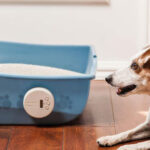As devoted pet owners, we strive to ensure our furry friends are happy and healthy. However, just like humans, dogs can experience a range of health issues, including the often-overlooked problem of cracked paw pads. These cracks can be uncomfortable and even painful for our canine companions, leading to limping or reluctance to play. Understanding what causes these paw pad cracks is essential in helping us prevent and treat this condition, keeping our dogs safe and comfortable.
In this article, we’ll explore the common culprits behind those pesky paw cracks, share tips on effective treatment methods, and provide practical advice on how to protect your pup’s precious paws. With a little care and attention, we can ensure our four-legged friends remain ready for all the adventures life has to offer!
Table of Contents
- Understanding the Causes of Cracked Paws in Dogs
- Identifying the Signs and Symptoms of Paw Cracks
- Effective Treatments for Healing Your Dogs Paws
- Preventative Measures to Keep Your Dogs Paws Healthy
- Q&A
- Final Thoughts
Understanding the Causes of Cracked Paws in Dogs
Cracked paws in dogs can stem from a variety of factors that may affect their overall paw health. One of the most common culprits is dry, cold weather, which can strip moisture from the pads, leading to cracking. Additionally, repeated exposure to harsh surfaces like pavement, gravel, or salt can cause wear and tear on their delicate paw pads. Other contributing factors include allergies, which can lead to excessive licking and subsequent damage, and infections, including fungal or bacterial conditions that compromise the skin’s integrity.
Understanding these causes empowers pet owners to take proactive measures. Regularly checking your dog’s paws for signs of wear and gently cleaning them after walks can help mitigate damage. You might also consider using paw balms or protective boots to shield their paws from rough elements. Keeping an eye on their diet and ensuring proper hydration also promotes healthier skin, leading to stronger, more resilient paw pads.
Identifying the Signs and Symptoms of Paw Cracks
When it comes to detecting issues with your dog’s paws, early observation is key. Paw cracks can manifest in various forms, and being vigilant about your dog’s behavior and paw appearance can help you identify them promptly. Look for signs such as:
Redness or Swelling: Any noticeable inflammation around the paw pads may indicate a problem.
Fissures or Cracks: These may appear on the pads, often accompanied by flaking.
Excessive Licking: If your dog is frequently licking or chewing their paws, it could signal discomfort.
Reluctance to Walk: If your furry friend is hesitant to walk or show signs of pain, that could be a clue.
Additionally, changes in your dog’s behavior can provide insights into underlying issues. Pay attention to any of the following indicators:
Unusual Gait: A noticeable limp or altered walking pattern can suggest paw pain.
Bleeding: Any bleeding around the paws or between the toes should be addressed immediately.
Odor: Foul smells can imply infections or other complications.
Effective Treatments for Healing Your Dogs Paws
Healing your dog’s paws requires a combination of gentle care and effective treatments. Start by inspecting the paws regularly for any signs of damage, such as cracks or redness. Keeping the paws clean and moisturized can greatly reduce pain and promote healing. Here are some effective treatments to consider:
Paw Balms: Use natural paw balms formulated with safe, moisturizing ingredients like beeswax and coconut oil to create a protective barrier.
Epsom Salt Soaks: Soak your dog’s paws in warm water mixed with Epsom salt to soothe and reduce inflammation.
Regular Trimming: Keep your dog’s nails trimmed to prevent further injury and to allow any cracks to heal properly.
Prevention is just as crucial as treatment. Ensuring your dog has protective footwear, especially in extreme weather conditions, can help prevent future cracks. Additionally, maintaining a healthy diet rich in vitamins and minerals supports skin health. Consider these preventative measures:
Hydration: Always provide fresh water to keep your dog hydrated, as this helps maintain skin elasticity.
Soft Surfaces: Encourage your dog to walk on soft surfaces instead of rough terrain to minimize wear and tear on their paws.
Routine Vet Check-ups: Schedule regular veterinary visits to monitor your dog’s paw health and catch any issues early.
Preventative Measures to Keep Your Dogs Paws Healthy
To ensure your dog’s paws remain healthy and free from cracks, it’s essential to adopt a few preventative measures. Regular grooming is vital; keep your dog’s paws clean and free of debris by washing them after walks, especially during the winter months when chemicals and salt are commonly used. Additionally, trimming the fur around the paws can help prevent ice and snow from getting stuck, which can lead to discomfort and cracking. Incorporating a good quality paw balm into your routine can provide a protective barrier against environmental irritants and keep the skin moisturized.
Another key factor in maintaining paw health is monitoring your dog’s weight. Excessive weight can place additional pressure on their paws, contributing to injuries or cracks over time. Ensure your dog is on a balanced diet and gets regular exercise to maintain a healthy weight. Furthermore, consider using protective booties during walks on rough or hot surfaces to shield their paws from harsh elements. By being proactive and attentive to these aspects, you can significantly reduce the risk of paw problems and keep your furry friend comfortable and happy.
Q&A: What Causes Cracks in Your Dog’s Paws? How to Treat and Prevent Them
Q: What are the common causes of cracks in a dog’s paw pads?
A: Cracks in your dog’s paw pads can arise from several factors. Some of the most common causes include:
- Dry Weather: Cold temperatures and low humidity can dry out a dog’s paws, leading to cracking.
- Excessive Activity: Frequent walking or running on rough surfaces can wear down the pads, making them prone to injury.
- Allergies: Food or environmental allergies can lead to inflammation and cracking of the paws.
- Infections: Bacterial or fungal infections can compromise the skin’s integrity, leading to cracks.
- Medical Conditions: Underlying health issues, such as diabetes or autoimmune disorders, can also affect your dog’s skin health.
Q: How can I identify if my dog has cracked paws?
A: To check for cracked paws, examine your dog’s paw pads and between the toes. Look for:
- Visible cracks or splits in the pads
- Redness or swelling around the affected areas
- Signs of pain or discomfort, such as limping or frequent licking of the paws
- Any unusual odor, which could indicate infection
Q: What are some immediate treatments for cracked paws?
A: If you notice your dog’s paw pads are cracked, you can take the following steps to help soothe them:
- Clean the Area: Gently wash your dog’s paws with mild soap and warm water to remove dirt and debris.
- Moisturize: Apply a dog-safe paw balm or moisturizer specifically designed for dry pads. Ensure it’s free from harmful ingredients.
- Limit Activity: Reduce walks or exercise until the cracks heal to prevent further irritation.
- Monitor for Infection: Keep an eye on the cracks for any signs of infection, such as pus or a foul smell. If these symptoms appear, consult your veterinarian.
Q: How can I prevent my dog’s paw pads from cracking?
A: Preventing cracks in your dog’s paws is all about proactive care. Here are some tips to keep their paws healthy:
- Regular Paw Checks: Make it a habit to inspect your dog’s paws regularly for any signs of dryness or damage.
- Moisturize Regularly: Use a paw balm during dry seasons or after walks on rough surfaces to keep pads hydrated.
- Avoid Harsh Surfaces: Limit your dog’s exposure to hot pavement, icy paths, or rough terrain, especially during extreme weather conditions.
- Hydration: Ensure your dog has access to plenty of water, as proper hydration supports skin health.
- Diet: A balanced diet with essential fatty acids can improve skin and coat health, which may help maintain healthy paw pads.
- Regular Vet Visits: Schedule routine check-ups with your vet to monitor your dog’s overall health and catch any potential skin issues early.
Q: When should I take my dog to the vet for cracked paws?
A: If your dog’s cracked paws are severe, bleeding, or showing signs of infection, it’s advisable to consult your veterinarian. Additionally, if the cracks do not improve with home treatment in a few days or if your dog exhibits persistent discomfort, seeking professional advice is essential. Your vet can provide tailored treatments and rule out any underlying health concerns.
By being proactive with your dog’s paw care, you can help prevent cracks and keep their paws healthy and happy!
Final Thoughts
understanding the causes of cracks in your dog’s paws is essential for maintaining their overall health and well-being. By being vigilant and proactive, you can identify early signs of paw discomfort and take the necessary steps to treat and prevent further issues. Regular grooming, avoiding harsh surfaces, and using protective balms can make a world of difference in keeping your furry friend’s paws safe and comfortable. Remember, a little extra care goes a long way in ensuring your dog can continue to explore the world with joy and without pain. If you ever have concerns about your dog’s paw health, don’t hesitate to consult with your veterinarian. With the right knowledge and attention, you can help your dog lead a happy, active life, free from the discomfort of cracked paws. Thank you for taking the time to learn about this important aspect of pet care!
















